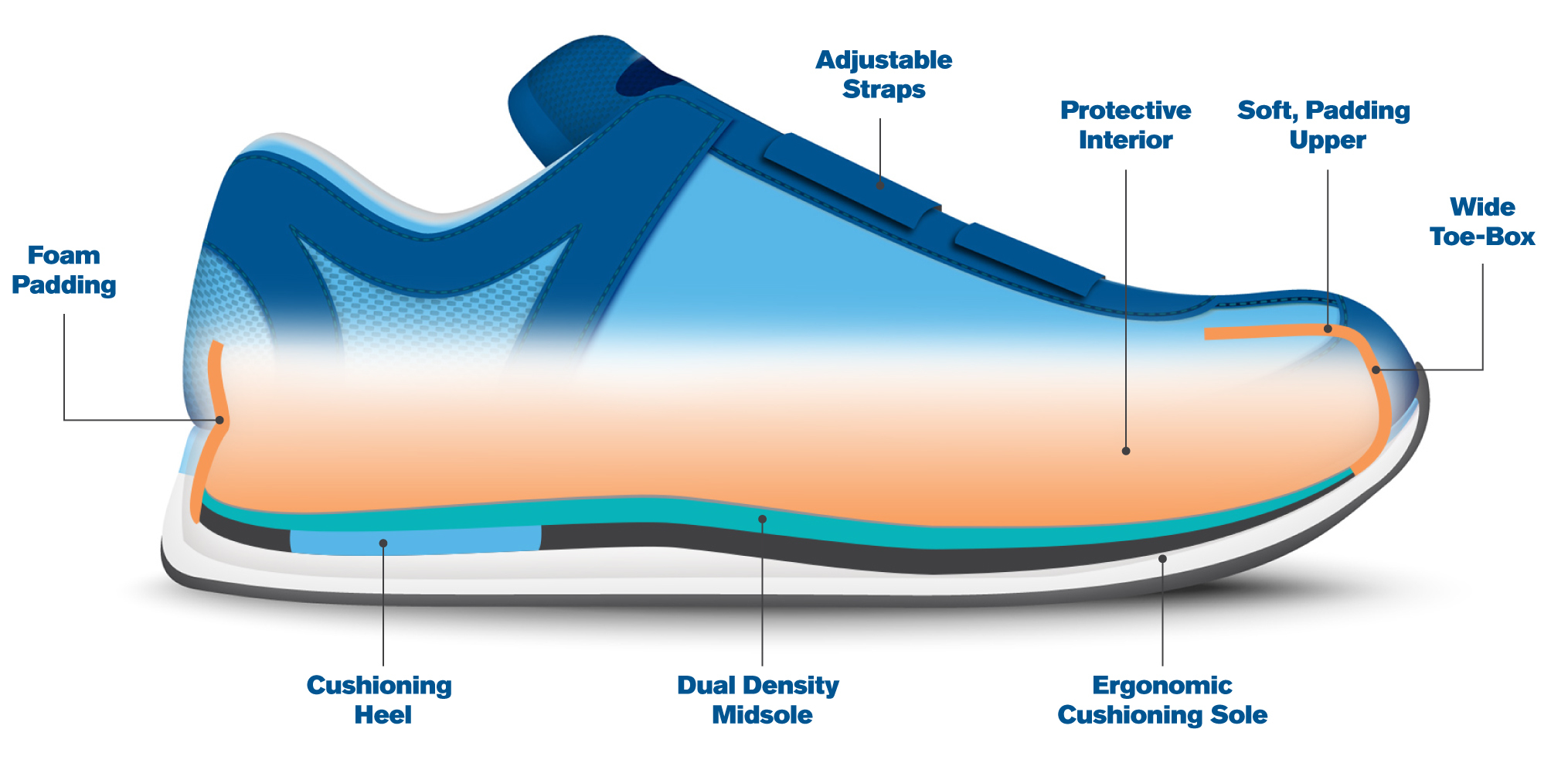
Did you know that humans have been wearing footwear for about 30,000 years?1 Originally intended simply as a protective covering, shoes have come a long way in changing how our feet feel and function.1 Read on to learn more about the best kind of footwear for people with gout and what to look for when you’re buying shoes for gout.
Choose the right shoes for gout
Wearing the right shoes for gout is especially important for people who suffer with the disease because it tends to strike in the feet.2 Research shows the best kind of footwear for people with gout is a sturdy shoe that offers good support, holds the foot in place (a feature known as motion control) and provides the appropriate amount of cushioning.3-6 In fact, the results of an 8-week study published in 2021 show that people who wore the right shoes for gout had less foot pain, impairment and disability.3
Listen to the experts
Researchers at the Auckland University of Technology in New Zealand have studied gout patients extensively to learn what kinds of shoes are best for people with gout. Here are some of their recommendations3-8:
Look for gout-friendly features.3-8
Characteristics of good shoes for people with gout include:
A wide and deep toe box. Shoes with enough room to accommodate a swollen big toe may feel better on your feet—especially during gout flares.6
Heel and forefoot cushioning. Adequate cushioning in the right places can protect the foot from impact and enhance comfort.4,5
A dual-density midsole.3,4 A dual-density midsole includes a device called a medial post.8 This medial post is more rigid than the rest of the midsole and helps provide extra stability and control (the rest of the midsole provides cushioning and additional support).8
A rocker sole. Rocker soles (thick soles that curve upward slightly at the toe and heel) encourage the feet to naturally roll forward with each step, minimizing impact.3,4,7
A zipper. Many people find that zippers can be a huge help when it comes to putting on and taking off shoes.4
Adjustable straps. Shoes that feature adjustable straps can help the wearer achieve a more customized fit.6
Pay attention to fit.
According to research published in 2018, more than 60% of people wear shoes that do not fit properly.1 In addition to causing discomfort, ill-fitting shoes can cause corns, calluses and other problems.1
Replace your shoes before they wear out.3
After you’ve had a pair of shoes for about six months, examine them carefully. If you notice significant wear or they just aren’t as comfortable as they were when they were new, it may be time to replace them.
Shop smart
When choosing shoes for gout, consider the following general advice9:
- Have both of your feet measured every time you buy new shoes (stand up for these measurements, as your full body weight may cause your feet to expand slightly).
- Shop for shoes later in the day (feet tend to expand as the day goes on).
- Understand that shoe sizes can vary from brand to brand and from style to style. Always try shoes on before you buy, and purchase the ones that fit best—regardless of the size.
- Allow a half inch of space between your longest toe (not necessarily your largest) and the tip of the shoe.
- If your foot is too wide for a certain shoe, ask if a larger width is available or consider buying a different brand. Avoid going with a larger size in the same shoe brand—it most likely will not be a better fit overall.
- Try on shoes with the same kind of socks you typically wear.
- Shop at a store with a wide range of shoe styles and prices and try on several different pairs. Keep in mind that the best shoes for your feet may not be the most expensive.
Ask your doctor to recommend shoes for gout
If you’re thinking about shoes for gout because you’ve been having gout flares more frequently, contact your doctor. You may need a dose adjustment in your urate-lowering therapy (ULT).10 (If you’re not currently taking ULT, you may need to start.10) Your doctor may also recommend a colchicine product to prevent flares such as Mitigare® (Colchicine) 0.6mg Capsules or Generic Colchicine 0.6mg Capsules.11 To learn more about how colchicine can help prevent gout flares, visit Mitigare.com.11
Mitigare® is a registered trademark of Hikma Pharmaceuticals USA Inc.
Colchicine 0.6 mg capsules are contraindicated in patients with renal or hepatic impairment who are currently prescribed drugs that inhibit both P-gp and CYP3A4. Combining these dual inhibitors with colchicine in patients with renal or hepatic impairment has resulted in life-threatening or fatal colchicine toxicity. Patients with both renal and hepatic impairment should not be given Mitigare®.
Fatal overdoses have been reported with colchicine in adults and children. Keep Mitigare® out of the reach of children.
Blood dyscrasias such as myelosuppression, leukopenia, granulocytopenia, thrombocytopenia and aplastic anemia have been reported with colchicine used in therapeutic doses.
Monitor for toxicity and, if present, consider temporary interruption or discontinuation of colchicine.
Drug interaction with dual P-gp and CYP3A4 inhibitors: Co-administration of colchicine with dual P-gp and CYP3A4 inhibitors has resulted in life-threatening interactions and death.
Neuromuscular toxicity and rhabdomyolysis may occur with chronic treatment with colchicine in therapeutic doses, especially in combination with other drugs known to cause this effect. Patients with impaired renal function and elderly patients (including those with normal renal and hepatic function) are at increased risk. Consider temporary interruption or discontinuation of Mitigare®.
The most commonly reported adverse reactions with colchicine are gastrointestinal symptoms, including diarrhea, nausea, vomiting and abdominal pain.
Please see the full Prescribing Information and Medication Guide for Mitigare® for complete product details.
NOTE: This article was not written by a medical professional and is not intended to substitute for the guidance of a physician. These are not Hikma’s recommendations for gout flare prevention, but rather facts and data collected from various reliable medical sources. For a full list of resources and their attributing links, see below.
